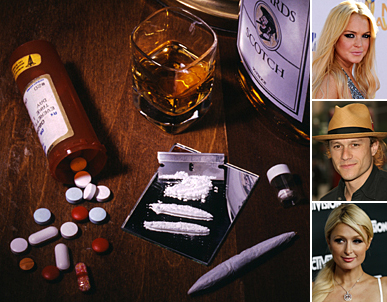Lindsay Lohan and Paris Hilton’s arrests have refocused attention on Hollywood’s drug problem. Now someone who once supplied drugs to his famous friends is talking.

The mugshots of Lindsay Lohan and Paris Hilton are by now all too familiar—as are the stories of celebrities in jail and rehab after drug convictions.
But how these stars get hold of their drugs is a lesser-known story.
Now, someone who once supplied famous friends with drugs is talking, shedding light on the seedier side of Hollywood living.
Chris Gardner was 22 years old when he headed to L.A. from his home in Iowa. It was 1999, and, before long, Gardner had landed a job at the Hollywood Reporter. By 2003, he had advanced to pen the nightlife column, “Reporter at Large,” a job for which he interviewed Hollywood royalty such as Halle Berry, Nicole Kidman and Naomi Watts, and hobnobbed with young celebs, including Lindsay Lohan, Paris Hilton and Nicole Richie.
For the shy, gay kid from Des Moines, who had been bullied in high school, Hollywood seemed enchanted at first. There he was, jetting off on private planes to Europe and Mexico. On a freelance trip to Cannes for another magazine, he recounts partying with Sting, Bono, Ricky Martin, Heidi Klum, Naomi Campbell, and Claudia Schiffer.
Yet, Gardner soon discovered that, beyond the glitz and glamour, Hollywood had a darker side—and that partying with celebrities came with a price. Before long, he had picked up a cocaine habit, sharing what he had, and getting his famous friends the drugs that they wanted. Gardner wasn’t motivated by money; it was all about access.
Gardner says he socialized, partied with “and did cocaine with dozens and dozens of actors.” Not all were A-listers, he says, and not all were actors. “I also partied with producers, studio executives, agents, managers, studio publicists, personal publicists and fashion professionals. And many times, my drug use got me access to people I never would’ve had the opportunity to hang out with otherwise.”
Every night of the week, there was a party somewhere in the city, and to go out, “meant to go out with cocaine in my pocket, and to party with celebrities until six in the morning,” says Gardner, adding that he spent as much as $1,000 a week on drugs—providing not just for himself but for others, too.
“There’s a lot of people who want to party with someone famous,” he says. “I wasn’t rich by any means. But I always had it. I think people recognized me as a party boy. There were several famous names who would ask me to take them to the bathroom.”
For Gardner, drugs were easy to handle in the beginning. And the first few years in L.A. were golden. By 2004, he was writing a nightlife column for People magazine, a job that required him to buddy up to hot female celebs and which carried both a deep expense account and flexible hours. Most days, after partying in the Hollywood Hills and hanging out at local hot spots, the gossip reporter would roll into the office around noon. Unknown to the magazine’s editors, Gardner’s nights were, by now, fueled by drugs.
“There was no doubt Chris was living the life he was reporting on,” says Todd Gold, the former managing editor of People. “With the kind of reporting he did, he was trading in gossip. You have to go out and assume the role of friend, or confidant, or party companion, or wiling cohort, and Chris did all that. The evil flip side is, he had to get up during the day and be a responsible working stiff. And it was hard.”
Gold says he wasn’t aware of what Gardner was doing until it was too late. “The way the gossip world is practiced—the editor and reporters are, in a sense, enablers. You want someone young and eager [who] is willing to participate. And as glitzy and glamorous as it can be, it has its dark side, and it can take its toll, like it did on Chris. It’s easy to cross the line, and you are no longer an observer and a gatherer of facts. You’ve become a participant.”
Every night of the week, there was a party somewhere in the city, and to go out, “meant to go out with cocaine in my pocket, and to party with celebrities until six in the morning,” says Gardner, adding that he spent as much as $1,000 a week on drugs—providing not just for himself but for others, too.
I knew I’d run into people who would want some—either celeb friends or scenesters—and I always wanted to be prepared,” says Gardner, who had begun to carry cocaine, and occasionally, Vicodin, Xanax, and Adderall. “A celebrity friend would call and say ‘come here and bring me this stuff.’ And I would,” he says. “Celebrities don’t want to be the one to do it. They [don’t] want to have to deal with the dealer.”
Gardner himself had several dealers to turn to. “I could call them all day and night,” he says. “I had dealers that worked bankers’ hours from nine to five. Others worked until three in the morning. Another one worked all night long. There was always someone to call when the drugs ran out.”
But with the drugs came an inflated sense of self. And Gardner started to neglect his job at the magazine. “People were taking my picture, too,” he says. “I was being interviewed. I thought I was so much more important than I really was.”
It all came to a head in September 2005 when police pulled him over on Rodeo Drive, and threw him in jail for a traffic violation, causing him to miss the Emmy party sponsored by People at the Sky Bar on the Sunset Strip. “It’s not every weekend a gossip columnist is arrested and put in jail on Emmy weekend,” he says. “At the time, it was such an embarrassment.”
People magazine subsequently fired Gardner but Daily Variety picked up the writer before the week was out. While at Variety, he covered serious business stories. “But at the same time, there was this other side. I loved to go out and snort cocaine in the Hollywood Hills till all hours of the night. I had some really difficult assignments but my phone would ring and Lindsay would call and I would go out…I called in sick a couple of times.” Eventually, he says, Variety Editor Peter Bart “left a note on my desk saying, ‘This ain’t working.'”
Daily Variety let Gardner go in November 2006, he says, adding that a failed attempt to launch a celebrity gossip blog for Cosmopolitan magazine followed. (Neither Daily Variety nor Cosmopolitan returned calls for comment.)
Eventually, he packed up his Nissan Pathfinder and drove back to Iowa. “I didn’t feel like a good person anymore,” he says, by way of explanation.
While drugs have always been a mainstay of the entertainment industry, a string of high-profile guilty pleas and sentences this fall (Lindsay Lohan and Paris Hilton, for example) has brought the problem back to the fore. And several deaths in recent years have prompted authorities to take a closer look at how celebrities obtain powerful prescriptions.
The death of actor Heath Ledger, 28, in 2008 was followed in 2009 by the death of 32-year-old actress Brittany Murphy who, authorities say, died of pneumonia exacerbated by multiple drug intoxication. Five months later, Murphy’s husband, Simon Monjack, also died—a death caused by acute pneumonia and severe anemia, according to the Los Angeles County Coroner.
Monjack also had prescription drugs in his system, and the L.A. coroner told The Daily Beast last week that Monjack had used various aliases to obtain Vicodin, Ativan, and hydrocodone and other prescription drugs for himself and his wife.
After the death of Corey Haim this year, the California attorney general told reporters that the actor had been “doctor shopping” for medications in the weeks before his death. In a period of 14 months, Haim had been prescribed 4,800 pills, including the powerful painkiller OxyContin, from seven doctors and multiple pharmacies.
John Niedermann, the Los Angeles County deputy district attorney, told The Daily Beast that authorities are still investigating Murphy and Haim’s deaths.
Dr. David Sack, the CEO of the drug-rehab center Promises, says that prescription-drug abuse has increased dramatically over the years. “Twenty years ago, we saw many people who had alcohol as their only drug,” he says. “Now we see many more people abusing multiple drugs. They are harder to treat.”
And drug users are getting ever younger. Prescription-drug overdose is the second biggest killer of teenagers after alcohol, according to Niedermann. Chris Webber, a counselor at Promises, says at least half the addicts treated at the rehab center’s outpatient program are under the age of 24. “We see a lot of people who are young, successful or affluent, or children of affluence,” says Sack. They “don’t seem to have an authentic friend in their life because everyone around them is attached to them because of money.”
Another problem, authorities say, are prescription-happy doctors who feed the appetite for prescription drugs. Some doctors become infatuated with the Hollywood lifestyle and “abuse prescription pads so they can be closer to the celebrity,” says Sarah Simpson, an agent with the California Bureau of Narcotics Enforcement. In San Diego County alone, Simpson has made more than 100 prescription-drug busts a year since 2000—roughly 10 to 15 percent of the cases involve licensed medical professionals, including doctors and nurses.
“We have definitely increased these investigations [and] there’ll be more prosecutions of these crimes in the future,” says Niedermann.
One example is last year’ successful prosecution of Carlos Estiandan, a 68-year-old doctor, who, during a three-month period in 2008, singlehandedly prescribed more prescription drugs to his patients than all the doctors at Johns Hopkins Hospital in Baltimore combined. Authorities began to suspect Estiandan when they pulled over a truck filled with opiates and cough syrup containing codeine made out in the doctor’s name. (Cough syrup mixed with 7-Up and red Jolly Rancher candies is a popular drink among Southern rappers. It is commonly known as Sippin Syrup or Sizzurp.) Estiandan “was charging 100 bucks a pop to write prescriptions and was seeing 40 patients a day,” says Niedermann, who prosecuted the case. “There were lines outside the door.” The doctor was subsequently charged with, and convicted of, providing a controlled substance to an addict and providing a controlled substance without a legitimate medical purpose. He was sentenced to five years in state prison.
Meanwhile, a Los Angeles jury is still deliberating on whether Anna Nicole Smith’s boyfriend Howard K. Stern, Dr. Khristine Eroshevich, and Dr. Sandeep Kapoor fed Smith’s addiction to prescription drugs out of self-interest. Prosecutors contend that they tried to use the drugs to further their relationship with Smith and were motivated by a desire for fame.
“There are a lot of Dr. Feel-Goods out there,” says a Hollywood entertainment agent who doesn’t want to be identified, adding that Hollywood scenesters share tips on which doctors are most discreet—and easiest to get prescriptions from. And drugs have lost their stigma in Hollywood. She recounts being at a friend’s house when the friend’s drug dealer showed up—along with two firefighters from the Los Angeles Fire Department. “Two firefighters and the drug dealer hanging out,” he says, adding that the firefighters knew what the drug dealer was doing.
Gardner is now 33 and one year sober. He manages a restaurant in Des Moines and has begun writing a book about his Hollywood life.
“I felt like the city was living me,” he says. “I really did have the best time, and I hung out with so many people. I had jobs that I never dreamed of having. But at the same time I got chewed up and spit out. There are so many friends of mine from high school and they would say ‘I can’t believe your life.’ But isn’t it a cliché? A small-town gay kid ends up on the red carpet, and then ends up in rehab.
It’s a story as old as Hollywood.
by Christine Pelesik

